
Should we Design Earthquake-Resistant Buildings in Australia?
Should we Design Earthquake-Resistant Buildings in Australia?
We think we don’t have earthquakes in Australia, and there is a reason behind this thinking.
Australia does not lie on a tectonic plate boundary.
To understand what it means, let’s have a look at the map below. There are seven major tectonic plates on earth. Put simply, when two plates collide, the result is an earthquake. Think of countries like Japan, Indonesia, Chile, and New Zealand which are close to the edges of tectonic plates and experience severe quakes quite frequently.

The major tectonic plates on earth.
Image source: Wikipedia
If you look at a global earthquake map, you will see Australia is relatively safe from this natural threat.
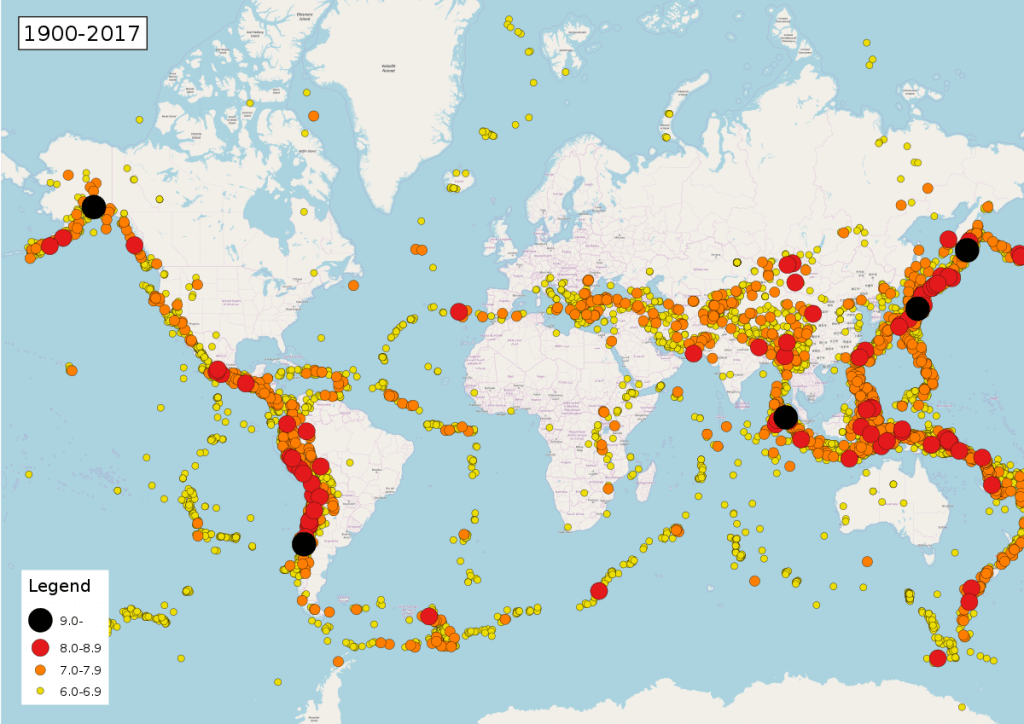
Global earthquake map
Image source: Wikimedia Commons
However, earthquakes do hit Australia. And there were times they hit strong.
In 1968 an earthquake hit Meckering in Western Australia, causing most buildings to be destroyed or badly damaged. No one was killed, but it’s reported that “forty-five families left town, never to return”.
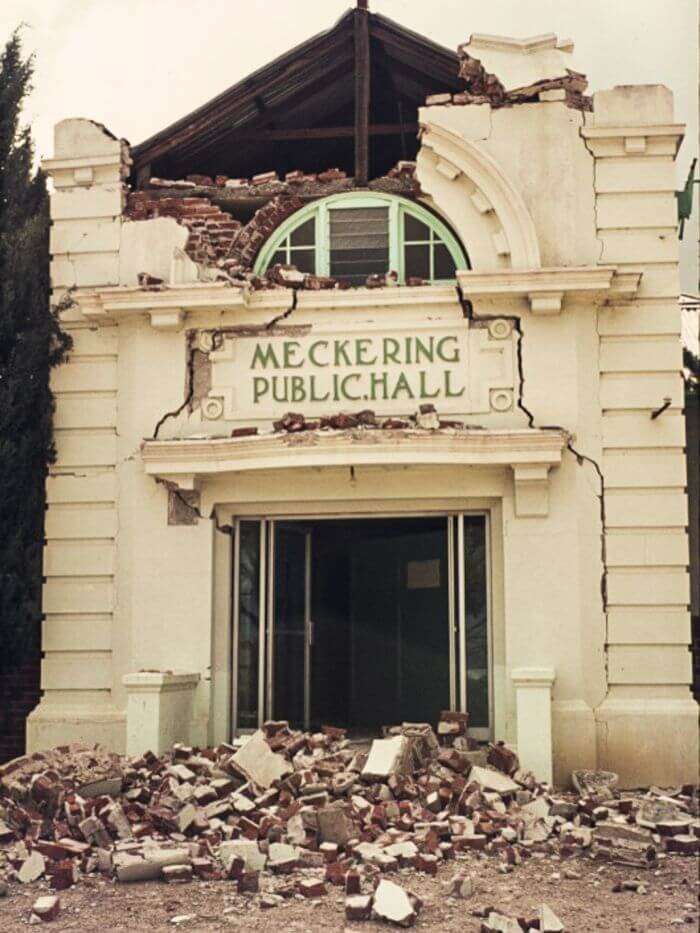
Damage caused by the Meckering earthquake.
Image source: Image source: ABC News
Another 6.8-magnitude earthquake hit Tennant Creek in 1988, “rupturing the gas pipeline between Alice Springs and Darwin”.
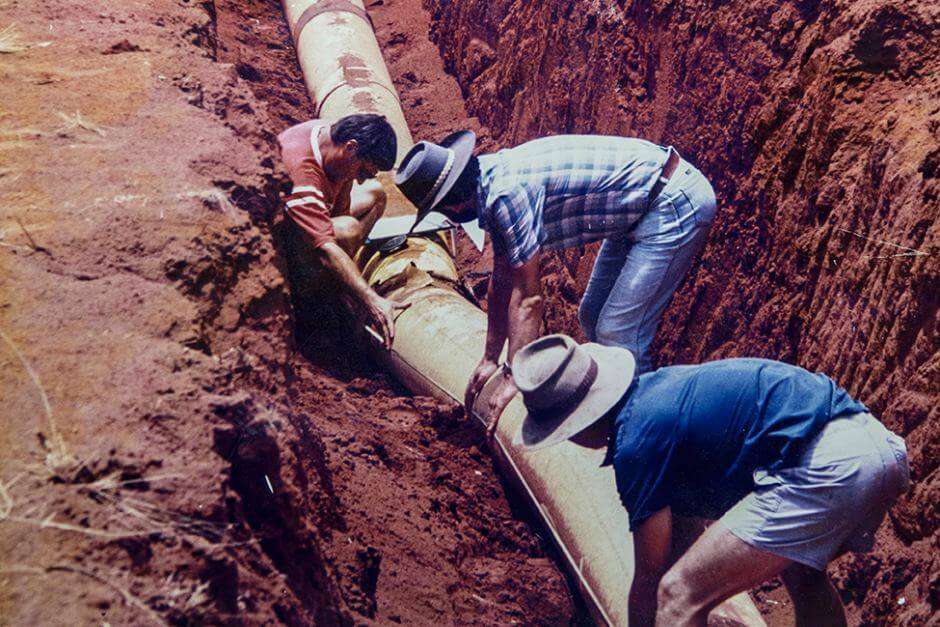
The damaged gas pipeline is being repaired after the Tennant Creek earthquake.
Image source: ABC News
The next one didn’t keep us waiting long. In 1989, the Newcastle earthquake killed 13 people, injured 160 people and forced the displacement of 1000. The damage bill hit A$4 billion.
Interestingly, Newcastle “had previously not been deemed to have any risk”, that’s why the buildings were not designed to withstand earthquake forces.

1989 Newcastle earthquake, After the 1989 Newcastle earthquake.
Image Source: Newcastle Herald
If the Meckering earthquake rang the first alarm in the Australian construction industry, after the Newcastle earthquake people started to question the efficiency of building codes. The time had come to review industry regulations with people’s safety and the resilience of buildings in mind.
Standards Australia, founded in 1922, published the first earthquake code (AS 2121) in 1979. This code was limited to buildings and houses in the Meckering area in Western Australia.
In 1994, the code was revised and reissued as AS 1170.4 in the Building Code of Australia. More details on the history of seismic regulations can be found in this article: Early History of Seismic Design and Codes in Australia.
How Many Earthquakes Do We Have In Australia Per Year?
Fortunately, most earthquakes in Australia are noticed only by seismologists.
Let’s have a look at the average frequencies and magnitudes of earthquakes in Australia:
– Earthquakes of magnitude 3 or more ─ around 100 earthquakes each year.
– Earthquakes of magnitude 5.0 – 6.0 occur on average every 1-2 years
– Earthquakes of magnitude 6.0 or more occur about every ten years.
Here is how GeoScience Australia explains the cause of earthquakes in Australia:
Australia sits on the Indo-Australian plate which is being pushed north at a rate of about 7cm per year and is colliding with other plates (the Eurasian, Philippine, and Pacific). This causes the build-up of mainly compressive stress in the interior of the Indo-Australian plate which is released during earthquakes.
At this point, there should be no doubt that we need to take the seismic hazard seriously while constructing buildings and infrastructure, because what we design now “is likely to be around for the next 100-200 years”, and we have the responsibility to minimize the impact of any future earthquakes on our communities.
Where Are Earthquakes Most Common In Australia?
Regions near Perth, Adelaide and the east coast are the most seismically active in Australia.
Earthquake activity in Australia since 1973, showing the clusters of seismically active regions.
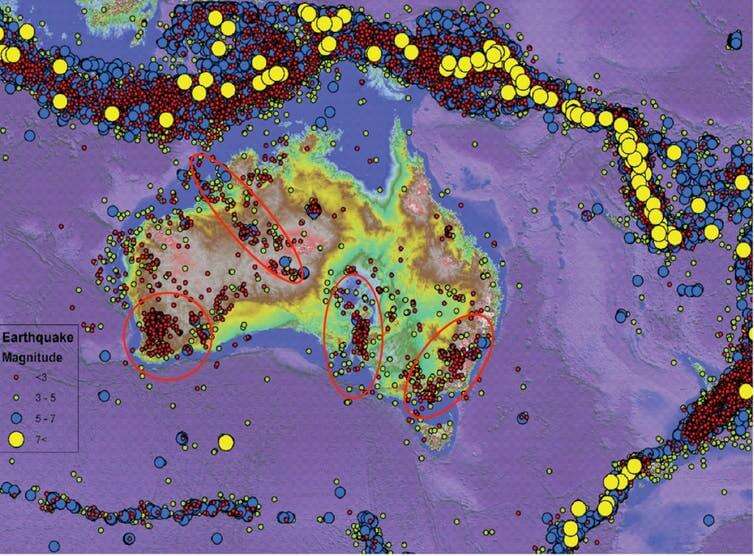 Image source: The Conversation
Image source: The Conversation
Western Australia is “a quake hotspot”, as we have the Darling Fault near Perth which can host large earthquakes, however, South Australia is also at risk as Adelaide is one of the most earthquake-prone of the capital cities.
There are earthquake hazard estimates for the ACT region, too. Canberra, for instance, faces a high earthquake hazard because of its proximity to Lake George, one of Australia’s most active faults.
In fact, most of the earthquakes in these regions are minor but they can also cause significant damage if buildings are not designed to withstand the earthquake loads.
Who Measures Earthquakes In Australia And How Is The Data Used By The Construction Industry?
Geoscience Australia (GA), a government agency, is responsible for providing 24/7 monitoring of seismic activity in Australia.
GA owns a project called National Seismic Hazard Assessment (the latest one being the NSHA18), which determines the level of ground-shaking hazard across Australia, identifies higher hazard areas and provides this information to the Australian Building Codes Board (ABCB) and Standards Australia.
Standards Australia uses this data to map out the seismic areas of greatest earthquake hazard and includes necessary updates in AS1170.4 Structural design actions, part 4: Earthquake actions in Australia.
In turn, the ABCB uses this data to develop mitigation strategies for earthquake events and implements the required amendments to the National Construction Code of Australia (NCC).
Today, the NCC outlines the performance requirements for commercial, public and multi-residential buildings (Class 2-9 buildings). Note that structural reliability provisions are specified in Part B1 of Volume Two of the NCC.
Designing Structures For Earthquake Loads In Australia.
First, let’s see why earthquakes cause damage.
When an earthquake hits, shaking in the ground causes the building’s foundation and the building mass to move in three directions ─ up and down, left and right, forward and back.
This means the building components should have sufficient strength and ductility to withstand the load reversals applied by an earthquake.
Shaking table tests illustrate this phenomenon quite efficiently.
What Factors Are Involved In Earthquake Design?
Earthquake (or seismic) loading is based on a number of factors such as:
- the location of the site,
- the soil conditions of the site (i.e. geotechnical parameters),
- importance level of the building,
- height of the structure,
- requirements for structural robustness of a building.
As we have seen above, the location of the building is tightly associated with the seismic hazard factor, therefore earthquake design has to be adapted to the location of the building.
The NCC Volume One shares the Importance Levels of Buildings and structures in Table B1.2a:
Level 1 |
Buildings with a low degree of hazard to life and other property in case of failure. |
Level 2 |
Default level – buildings not assigned levels 1, 3 or 4. |
Level 3 |
Buildings designed to contain a large number of people. |
Level 4 |
Buildings essential to post-disaster recovery or hazardous materials facilities. |
The NCC Volume Two presents a chart with the definition of construction site classes based on the soil category. Check out the table here: Table 3.2.4.1 General definition of site classes.
Sign in to ABCB’s website to access the NCC and see the full details of Volume One and Two requirements.
In terms of the height of a building, buildings of less than forty storeys should be given more attention, because Class 1 buildings (which are higher than forty storeys) have robust requirements to withstand wind forces. These requirements are sufficient for the structures to also “handle” earthquake loads.
Determining The Required Loads
Seismic loading means “application of an earthquake-generated agitation to a structure” and it’s a key concept in earthquake engineering.
Seismic load indicates how much seismic energy (energy released during an earthquake) a structure would need to endure an earthquake.
We need to introduce two concepts before we proceed: dead loads and live loads.
Dead load is the self-weight of a building, i.e the weight of the construction material and the structural elements of a building (beams, floor slabs, roof, columns, and walls). Dead loads are static so they place continuous and permanent forces on a structure.
Conversely, live loads are variable loads. They include furniture, people, equipment, vehicles – anything that’s related to the intended use and capacity of a building. Being moving or moveable loads, live loads are temporary and can vary greatly.
Here is an instructional video to learn how to calculate dead loads and live loads.
Apart from dead loads and live loads (AS1170.1), buildings are also affected by lateral loads, for example, wind loading (AS1170.2), snow loading (AS1170.3) and earthquake loading (AS1170.4).
Section 3 of AS 1170.4 applies a hazard design factor to all regions of Australia and requires earthquake loads to be considered in the design of any building.
The Load Path Of Buildings
Live and dead loads, which act on the roof and floors of a building, are transferred to the columns and walls, then down to the supporting footings and foundations.
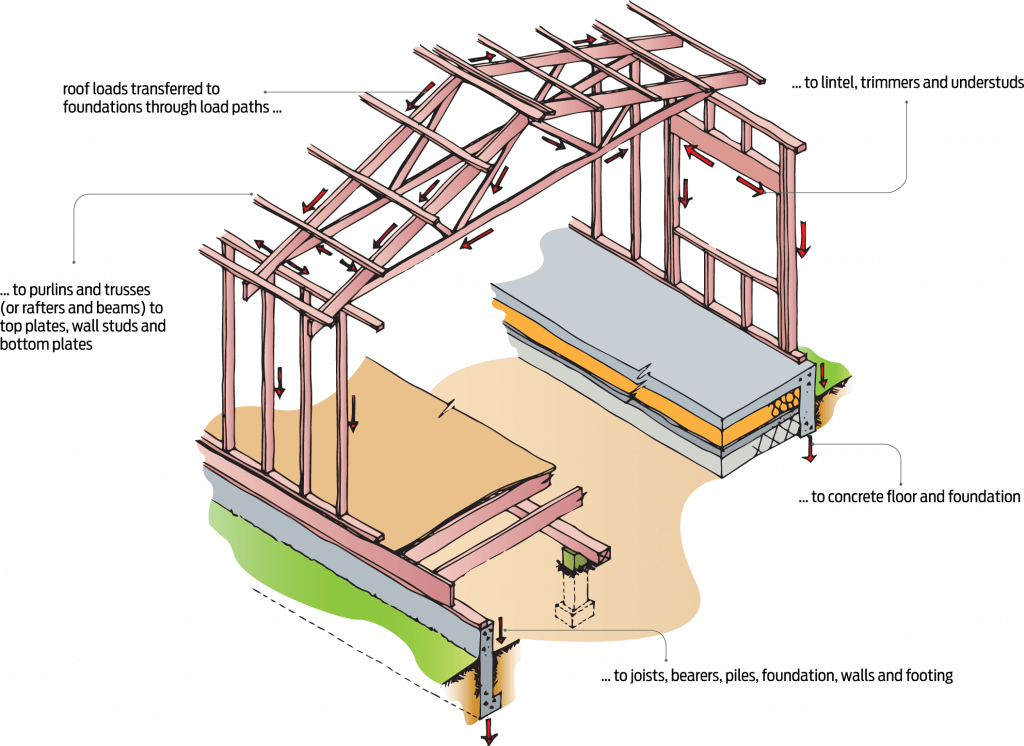
Vertical load paths
Image Source: Build Magazine
This means both structural and non-structural components of a building should be constructed the way that they are “able to deform with the earthquake and absorb energy without vertical supports giving way”.
Structural elements of the building are roof systems, beams, load-bearing walls, floor systems, columns which “share the responsibility” for the seismic resilience of the entire structure.

Example of structural damage after an earthquake.
Image source: Australian Geographic
Non-structural building elements include: non-load-bearing walls, chimneys, parapets, partitions, ceilings, as well as mechanical and electrical components (smoke control systems, fans, air conditioning equipment, elevators, etc.)
 Example of non-structural damage after an earthquake.Image source: Building Performance
Example of non-structural damage after an earthquake.Image source: Building Performance
It may seem that non-structural elements are of less importance, but during an earthquake chimneys, gable ends or parapets “may significantly impact the level of risk posed to building occupants”.
Section 8 of AS 1170.4 provides information about non-structural building parts and components that would need to be designed to resist earthquake forces (Class 2-9 buildings).
What’s The Goal Of These Policies?
No design requirement will guarantee an undamaged building in the event of an earthquake.
It’s important to note that the major goal of these policies is to prevent collapse in order to save lives and minimize damage to the structure to reduce retrofitting costs.
Preventing collapse is becoming more and more important as our cities become bigger and more densely populated.
NCC Volume One contains a Performance Requirement (BP1.1) that requires Class 2 to 9 buildings to perform adequately under all reasonably expected design actions, including earthquake actions.
The Challenge With The Existing/Older Buildings
Many older buildings in Australia, especially those designed in the 1970s and earlier, may lack adequate seismic resilience required by current legislation.
Codes and regulations mainly address the earthquake design of new buildings; however, Australian Standard AS3826 also contains provisions for strengthening existing buildings “in accordance with the strength limit in each state”.
In Australia, existing buildings considered most vulnerable to earthquakes are the following types:
- Old un-reinforced masonry cavity brick construction
- Soft-storey construction
- Load bearing single storey construction
- Building façade systems constructed from unreinforced masonry or glass panels
Cities are also at risk as they comprise old infrastructure made of unreinforced brick and masonry, which “is particularly susceptible to earthquake damage”.
One of the key issues in the industry is building owners who upgrade their buildings to comply with the NCC standards “do so by choice rather than being forced to do so”.
This problem becomes even more pressing in the case of post-disaster buildings. These buildings are of strategic importance and will pose significant consequences if the continuity of their services is not ensured (such as hospitals, power generating stations, communications facilities, etc.).
Summing Up!
Designing earthquake-resistant buildings is a tough challenge and requires team efforts to be carried out successfully.
Builders, engineers, designers, architects, manufacturers, certifiers, and building control authorities — all of them should be well-trained and experienced in the construction field to tackle the existing problems and ensure compliance with laws and regulations.
A nationally recognized training provider Back to Basics is here to help.
Here is what you get when you choose our courses:
- You receive high-quality training at an affordable price.
- You learn how to apply building codes and standards to the construction process.
- You gain access to training materials written by builders for builders.
- You receive one-on-one training from industry experts.
If you would like more information on the courses Back to Basics offers or are interested in upgrading your resume with one of our qualifications, Call us on 1300 855 713 or email enquiries@backtobasics.edu.au to find out more.